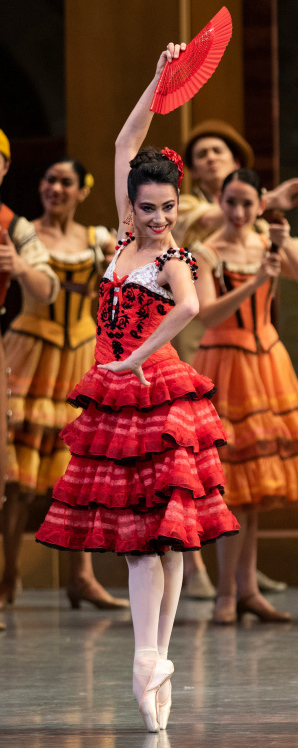San Francisco Ballet opened its 2019 season this past Friday with Don Quixote, a story ballet loosely based on the classic Spanish novel, Miguel Cervantes’ wry satire of a minor Spanish nobleman who has read so many chivalric romances that he is driven mad. Petipa’s 1869 version of the ballet, however, was like the story ballets of the time, a romantic portrayal of love. The complex and tragicomic knight of the 17th-century novel puts in a very minor but comic appearance. Don Quixote is one of the happiest story ballets, where the lovers celebrate their love in a final act marriage celebration, stunningly garbed in snowy white tutu and spangled bolero.

Set to the broad gestures of Ludwig Minkus’ score, the ballet opens with a short prologue in which Don Quixote dreams over a book and is suddenly awakened by the appearance of three housewives searching for the rotund Sancho Panza, who has stolen a ham and is now hiding under Quixote’s table. Sancho was danced by Pascal Molat who, returned from retirement, has taken on the broadly comic role along with the necessary padding (not his own). He remains a breathtakingly beautiful dancer, as he showed last year in a guest appearance with the newly formed chamber company, SF Danceworks. But he also excels at drolly comic roles.
The housewives sent off, the mad knight and his buffoonish squire set off to conquer evil and save damsels in distress. The damsel in distress in this ballet is Kitri, whose father (Val Caniparoli) is trying to marry her off to a wealthy nobleman, Gamache (Alexandre Cagnat).
Kitri was danced by Mathilde Froustey on opening night, partnered by Angelo Greco, in the role of her true love, the lowly but ardent young barber Basilio. The two are beautifully matched and it’s clear from the abandon with which Froustey throws herself into lifts that she trusts her partner completely. Both have excellent technique, delicate and assured at the same time, gracefully precise.
Running off, the two lovers are pursued by father, Gamache, Don Quixote and Sancho. Quixote has mistaken her for Dulcinea, the object of his chivalric love.
The scene shifts to a gypsy encampment, where Kitri and Basilio hope to hide away from their pursuers, and where the audience is allowed to enjoy fiery dancing by Hansuke Yamamoto as the Gypsy King and Kimberly Marie Olivier, a barefoot gypsy girl. After more interludes with the many comically pursuing characters, the lovers escape again and Don Quixote falls exhausted, the victim of a battle against a windmill.
In his sleep, Quixote dreams of driads and cupids, ably portrayed by the corps led by the exquisite Koto Ishihara and the adorable Norika Matsuyama. One of the admirable features of the story ballets is that everyone gets to dance, from chorus to soloists to principals. And in this case, students of the SF Ballet School portrayed the Little Cupids as well.
The last act is Kitri’s Wedding, complete with grand pas de deux and all the grandeur of the world of Imperial Russian ballet. This version of Don Quixote, included choreography by Petipa and Gorsky, embellished by additional choreography by Helgi Tomasson and choreographer-in-residence Yuri Possokhov. The contemporary choreography fit seamlessly into the original choreography. As simple as the ballet story may be, classical choreography remains a challenge. It demands precise technique and extraordinary balance delivered effortlessly. Don Quixote also requires a sunny vibrancy. None of that was lacking in this charming, audience-pleasing production.
– Jaime Robles
San Francisco Ballet’s Don Quixote continues through February 3. For tickets and information, visit sfballet.org.
